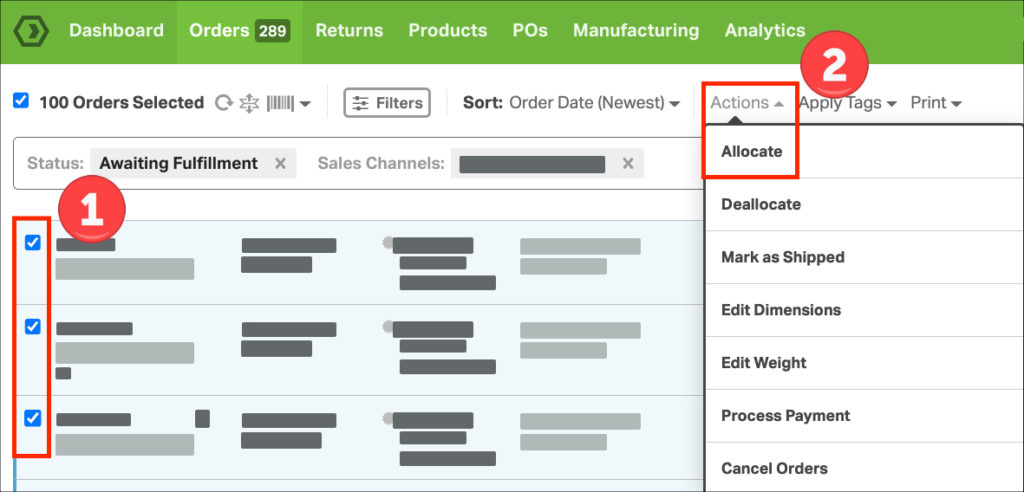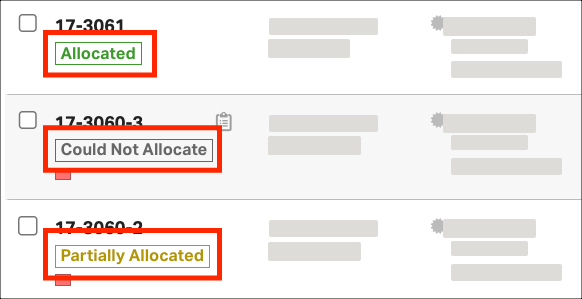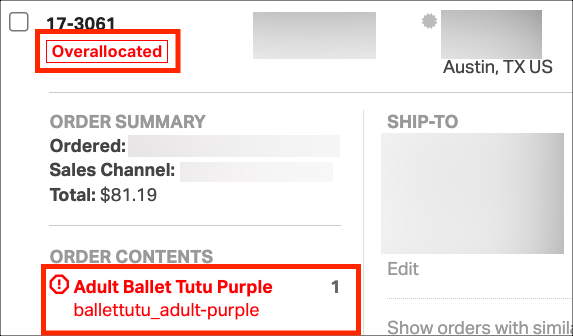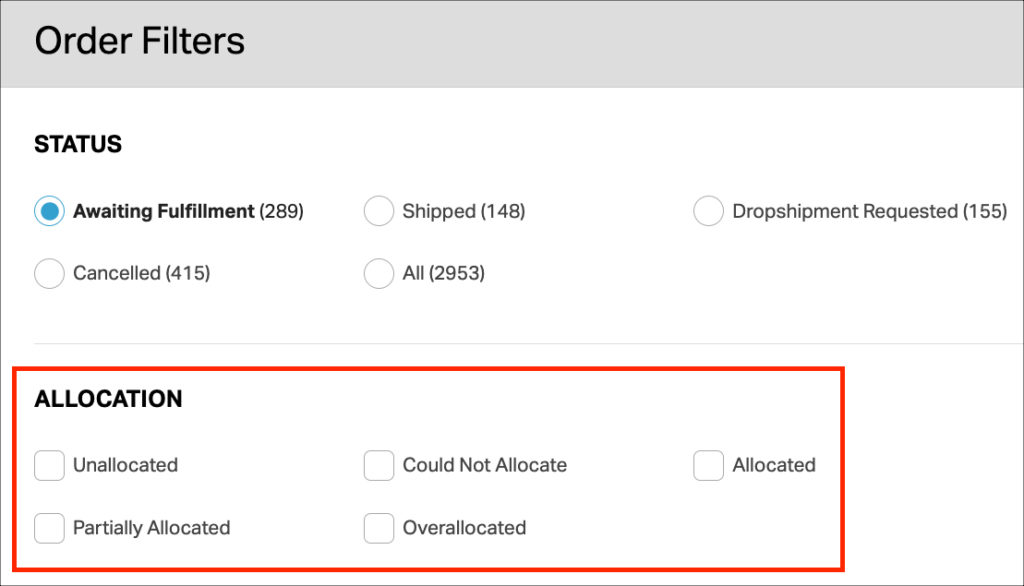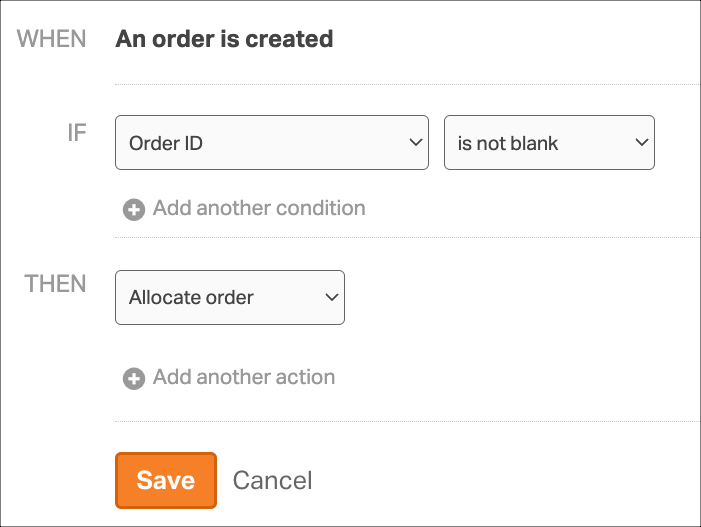Allocation Basics
To enable Allocation or ask questions about the feature, please email our Support team at support@ordoro.com.
NOTE: This feature is exclusively for customers that have opted into the Allocation module.
Topics
What is Allocation?
- Allocation checks if the assigned warehouse has adequate inventory to fulfill an order. It will review all related orders for a given SKU.
- When an order is allocated, inventory is set aside for the order.
- Allocating an item to an order doesn’t affect your actual inventory. It ensures accurate fulfillment of orders based on current stock levels.
Overview of Allocation statuses:
- Unallocated
- The original state of the order. Allocation has not been run on the order.
- Could not allocate
- Allocation has run on the order, but there is not enough inventory for the order.
- Allocated
- Allocation has run on the order, and there is enough inventory to fulfill the order.
- The order is ready to ship.
- Partially Allocated
- Allocation has run on the order, and there is enough inventory for some of the order lines. Other products on the order do not have inventory to allocate.
- Overallocated
- The order was allocated, but since the time of allocation, the physical on hand inventory was reduced.
- The inventory reduction could be due to a shipped unallocated order or a manual adjustment.
- The products on this order no longer have enough inventory to be allocated.
- It’s best practice to review Overallocated orders to clean them up.
Other notes about Allocation:
- Only orders in the Awaiting Fulfillment status can be allocated.
- When orders are shipped, canceled, or dropshipped, Ordoro will remove the allocation.
- Sorting matters when Allocation is run for multiple orders.
- If you want orders to allocate First In, First Out (FIFO), be sure to sort the orders by Order Date (Oldest).
- Instances when Allocation is automatically removed and should be re-run:
- When a product is added to an allocated order.
- If the ordered quantity is updated on an allocated order.
- Updating the physical on-hand quantity of a product does not automatically update the allocation status.
- Manual re-allocation of orders is required after inventory adjustments to give users control over which orders are fulfilled.
- The Allocation feature replaces the Standard shippability feature.
Using the Allocation feature in Ordoro
- Go to Orders -> Awaiting Fulfillment. Select the orders you want to run Allocation.
- Select Actions -> Allocate.
- Note: In the screenshot below, the orders are sorted by newest first.
- If you want orders to allocate FIFO, make sure to Sort by Order Date (Oldest).
When Allocation has completed running, the Allocation status is shown per order.
- Orders in the Allocated status are ready to be shipped out.
- Orders in the Could Not Allocate status are not ready to be shipped.
- Orders in the Partially Allocated status can be split to ship items with enough inventory allocated. Or you can keep the order intact, wait for the remaining stock needed, and ship the whole order.
How to fix Overallocated orders
- Overallocation occurs when an order is initially allocated, but then the physical on-hand quantity of the product is reduced, resulting in a quantity that is less than the ordered amount.
- All open orders with the item will receive the Overallocated status because Ordoro doesn’t know how to allocate the remaining inventory.
- When you see the Overallocated status, you should review your orders and adjust the Allocation accordingly.
- One solution to resolve Overallocated orders is to deallocate the orders and then Allocate again.
Overallocated example:
- An order was placed for the purple tutu.
- In Ordoro, the item’s inventory quantity was one so the full quantity was allocated to the order.
- Another order with the tutu was created in Ordoro and shipped even though it wasn’t allocated.
- This reduced the tutu inventory quantity from one to zero.
- The original order is now Overallocated because there is not enough inventory on hand even though it was originally Allocated.
- Suggested workflow: Once you receive more tutus, search Awaiting Fulfillment orders by the tutu SKU. Then unallocate and reallocate.
Allocation Filtering
Once Allocation has run on orders, you can filter orders by Allocation status in the Orders tab.
1. Go to Orders -> Filters.
2. In the Filters modal, select which Allocation status(es) to filter by.
Automating Allocation
Automation rules can be created to automatically run Allocation on your orders.
Rules can be configured in various ways to align with your business requirements. For instance, a rule can be set up to allocate inventory only to orders from Texas, ensuring that orders shipping to Texas are prioritized for allocation.
Below is an example rule to allocate all orders. Click here for more details on how to set up automation rules in Ordoro.
Additionally, Ordoro can enable a custom script to clean up your overallocated orders. See the workflow below.
What does the Allocation script do?
Step 1: Fix Overallocated Orders
- Find the overallocated orders
- It starts by finding all Awaiting Fulfillment orders that have been marked as overallocated. We review them from the newest to the oldest.
- Unallocate the orders
- Each order is unallocated one at a time until there are no overallocated orders left.
- Why one at a time? As you free up inventory by unallocating orders, the allocation status of earlier orders might change because they can now access the inventory that just got freed up. So, taking it one order at a time helps manage this smoothly.
Step 2: Update Allocation for All Orders
- Collect orders needing updates
- Orders are gathered from oldest to newest in the following allocation statuses: could not allocate, unallocated, or partially allocated.
- Try to allocate again
- For each order in the list, attempt to allocate each order.

